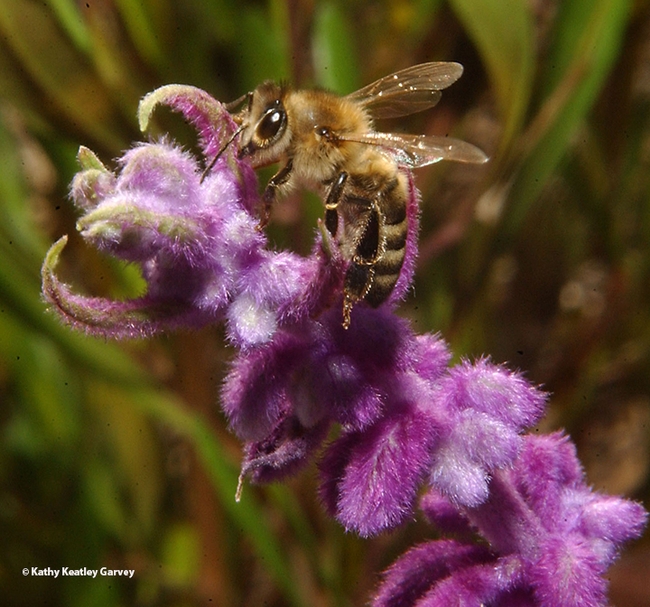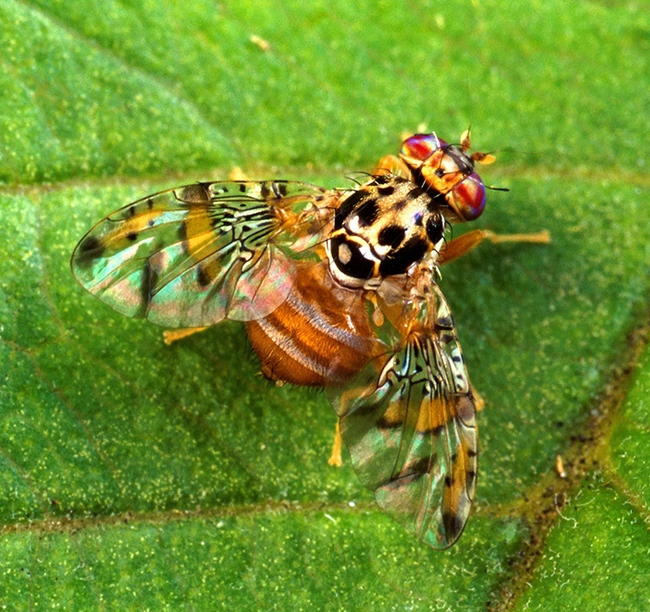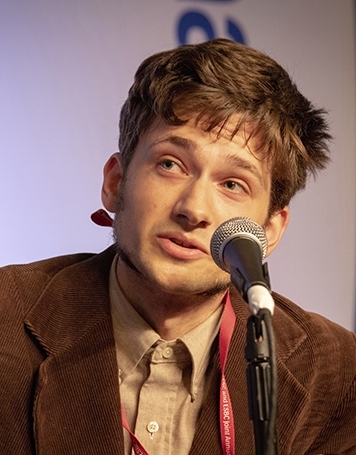- Author: Kathy Keatley Garvey
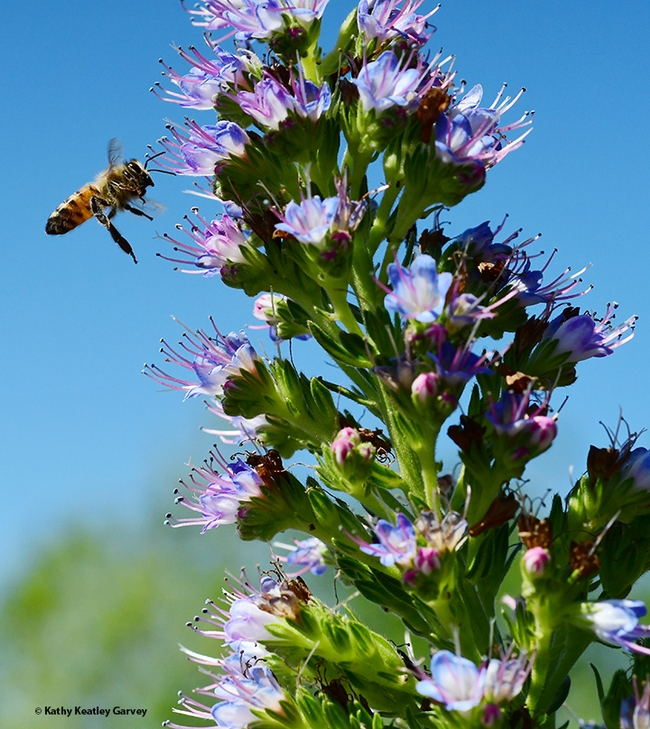
Now another "pride" awaits.
Z Specialty Food will host a Nature Day celebration, a free public event from 11 a.m., to 5 p.m., Saturday, April 2.
The 20,000-square-foot facility, which houses the Moon Shine Trading Company, Island of the Moon Apiaries, and The Hive, includes a processing plant, a tasting room (honey and mead), a gift shop, an outdoor courtyard and a pollinator garden. As the largest honey varietal business in California, it is the pride of all folks eager to say: "Show me the honey!"
And now on Saturday, April 2, during the Nature Day celebration, you'll see the pride of The Hive.
What's on tap for Nature Day?
Don't Toss Those Scraps! – Natural Dye Workshop
Time: All day
Learn how to utilize food scraps and create one-of-a-kind dyes for clothing, fabric and yarn. You'll be provided white cloth, avocado pits and black beans. What's with food waste? Each year Americans waste 108 billion pounds of food, contributing to extensive environmental, economic, and societal impacts.
Miridae Living Labs
Time: All day
You'll get to play with seed bombs, bugs, and plants with Miridae Living Labs! This is a non-profit, Sacramento-area organization dedicated to using native insects and plants as tools for education, research, and community engagement. The business "strives to generate positive ecological changes in our communities under the guidance and leadership of community members," a spokesperson said.
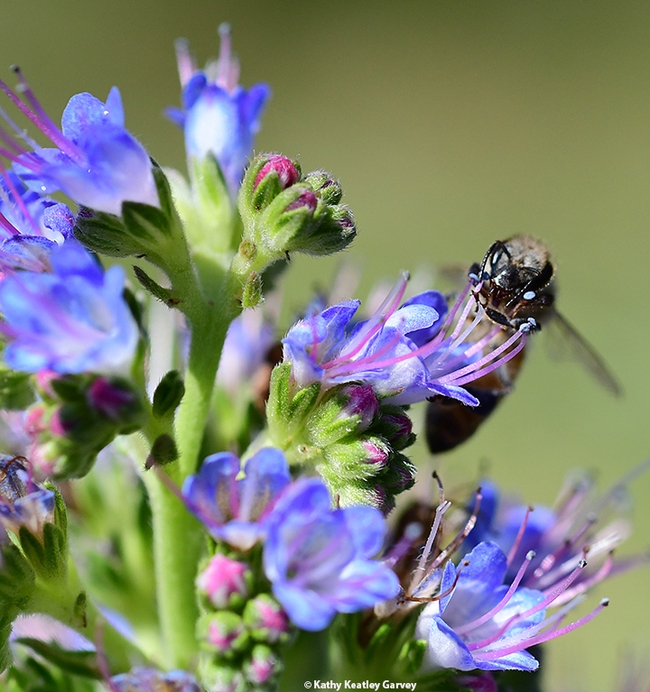
Noon: Container Gardening with California Native Plants (first-come, first-serve basis with purchase of plant)
Miridae Mobile Nursery is a customized box truck that transforms into a curbside native plant shop. Its goal is "to bring people together through plants and gardening." All profits from its sales of native plants support its science education, non-profit Miridae Living Labs.
The Hive Nature Loop Scavenger Hunt
Time: All Day
You can grab a pamphlet and go on a scavenger hunt for plants in The Hive Nature Loop. Find all the plants and show to a team member to win a prize!
Pollinator Garden Tour
Time: 1 p.m.
Join plant curator Rowan Boswell for a tour of the two-acre pollinator gardens at The Hive. It's billed as: "Get inspired by our oasis and outdoor courtyard, designed to meet the needs of our community and native species. Discover pollinator favorites, California natives, and drought-tolerant plants."
Bohart Museum of Entomology
The Bohart Museum of Entomology at UC Davis will display specimens of bees. The insect museum, directed by Lynn Kimsey, UC Davis distinguished professor of entomology, is the home of a global collection of eight million insect specimens; a live "petting zoo" (Madagascar hissing cockroaches, stick insects and tarantulas); and a gift shop.
Photography
Some 24 images of honey bees by award-winning photographer Kathy Keatley Garvey of UC Davis will be showcased. A communication specialist for the Department of Entomology and Nematology who takes images of honey bees and other pollinators in her leisure time, she comes from a long line of beekeepers. She writes a daily (Monday-Friday) Bug Squad blog.
The Hive Facility Tour
Times: 11 a.m. and 2 p.m.
Visitors are invited to tour the four-year development, created to educate the public on honey, bees, and pollination. Nectar director Josh Zeldner will guide the tours of 20,000-square-foot, Zero Net Energy facility.
Z Specialty Food began as the Moon Shine Trading Company, founded in 1979 by Ishai Zeldner (1947-2018), who died at age 71. He worked as a commercial beekeeper and studied beekeeping at UC Davis. He became fond of yellow starthistle honey. "He loved it so much that he began giving it away to his friends, and quickly realized he was going broke doing so," remembers his widow, Amina Harris, the director of the UC Davis Honey and Pollination Center. Her title at the family business? "Queen Bee." Son Josh Zeldner is the "nectar director." Liz Luu is the marketing manager and tasting room manager, or a "worker bee."
Honey enthusiasts all, they and their crew will greet the public on Nature Day, April 2. The bees will be there, too, foraging on the Pride of Madeira.
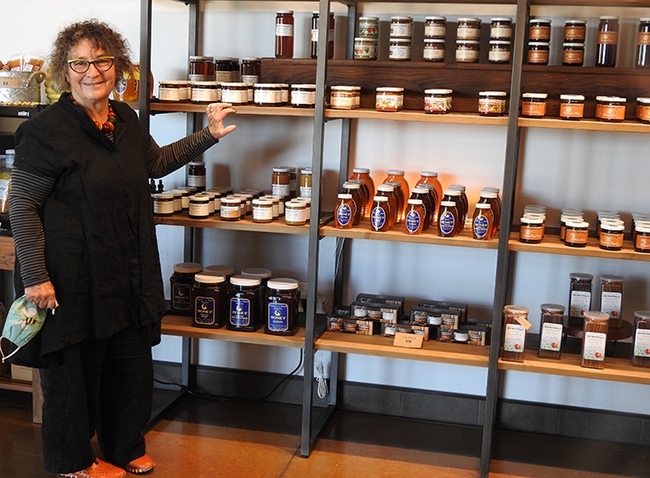
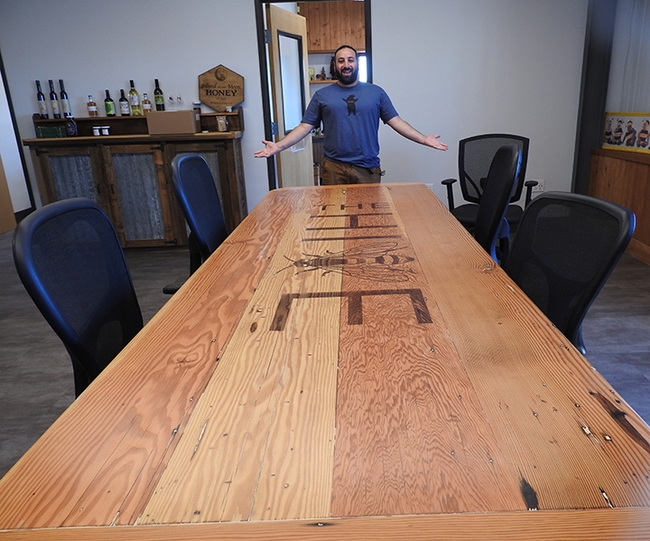
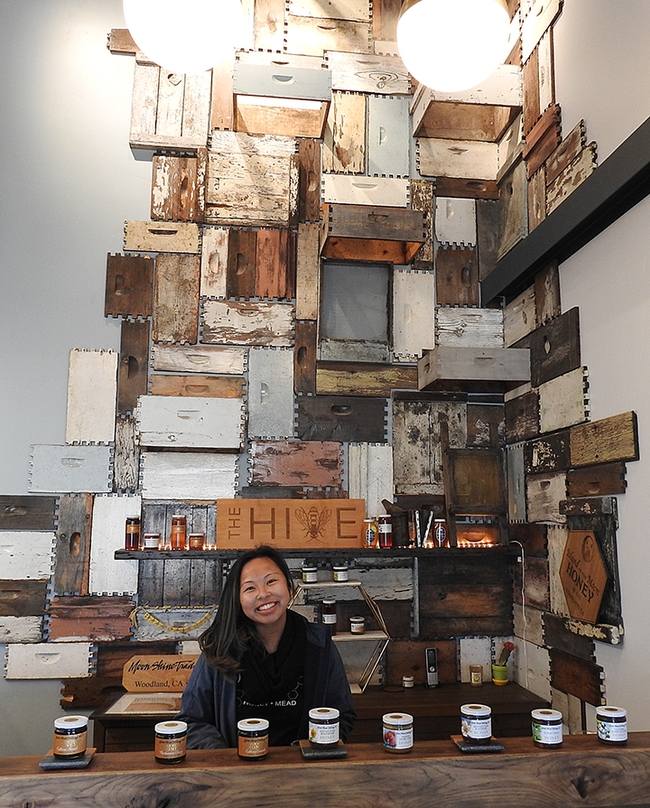

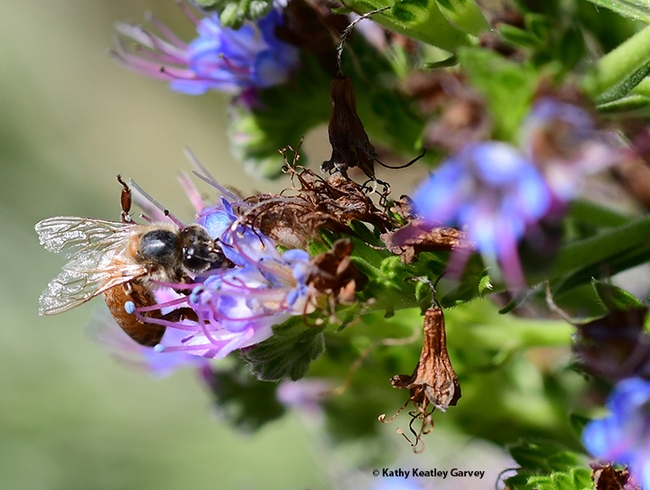
- Author: Kathy Keatley Garvey
"Kleptopharmacophagy, a newly described behavior recently observed in milkweed butterflies, is characterized by adult butterflies feeding on milkweed caterpillars. What type of alkaloids do the adult butterflies presumably gain as a result?"
That was one of the questions posed during the Entomology Games at the 2021 Entomological Society of America (ESA) meeting.
What's the answer? Pyrrolizidine alkaloids.
What, you ask, are the Entomology Games? A lively question-and-answer, college bowl-style competition on entomological facts played between university-sponsored student teams, as ESA says.
If you've ever been to the Entomology Games (formerly the Linnaean Games), you know how wonderfully educational and purely entertaining they are. Check out the list of YouTube videos in the championship matches. The 2018, 2016 and 2015 videos are there. The UC Entomology Games Team (UC Davis and UC Berkeley) won the nationals in 2018, and UC Davis in both 2016 and 2015.
Next month is the Pacific Branch, Entomological Society of America (PBESA) competition, with the championship team and runner-up team eligible to complete in the nationals.
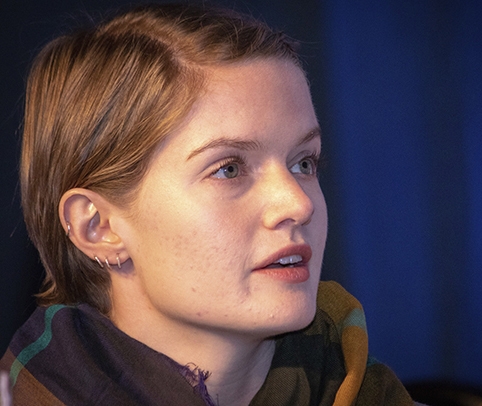
The PBESA meeting takes place April 10-13 in the Hyatt Regency Sonoma Wine Country. Santa Rosa. The preliminary round is from 5 to 6 p.m., April 10. Plans are to hold three rounds with questions from each of the 10 categories: Biological Control, Behavior and Ecology, Economic and Applied Entomology, Medical-Urban-Veterinary Entomology, Morphology and Physiology, Biochemistry and Toxicology, Systematics and Evolution, Integrated Pest Management and Plant-Insect Interactions, History of Entomology, and Entomology in Popular Culture. (See 2021 sample questions.)
The final round is from 8 to 10 p.m., April 11. Then the top two PBESA teams will head to the nationals. The Nov. 13-16 ESA meeting n Vancouver, British Columbia is a joint meeting with the Entomological Society of Canada (ESC), and the Entomological Society of British Columbia (ESBC). The theme: "Entomology as Inspiration: Insects through Art, Science, and Culture."
Some of the questions asked at previous matches have involved the work entomologists affiliated with the UC Davis Department of Entomology and Nematology:
- Emerita Mary Lou Flint, a longtime leader of the UC Statewide Integrated Pest Management (UC IPM) Program and an Extension entomologist based in the department;
- Rebecca Godwin, who received her doctorate from UC Davis and is now an assistant professor of biology at Piedmont University, Demorest, Ga.; and Jason Bond, the Evert and Marion Schlinger Endowed Chair and associate dean, UC Davis College of Agricultural and Environmental Sciences.
- Robbin Thorp (1933-2019), distinguished emeritus professor known for his expertise on bumble bees, including Franklin's bumble bees, now feared extinct
Q. Mary Lou Flint's textbook, IPM in Practice; Principles and Methods of Integrated Pest Management, cites the management of what invasive plant, first introduced to North America from Europe, as an "excellent example of classical biological control in the Western US?" This plant was controlled by importing the European chrysomelid beetle Chrysolina quadrigemina.
A. Klamath weed / St. John's Wort / Hypericum perforatum
Q: In early 2021, (Rebecca) Godwin and (Jason) Bond described 33 new species of the trapdoor spider genus Ummidia, including a species named in honor of what alt-country singer-songwriter, who was the most-nominated woman at the 2019 Grammy Awards? She has had success both as a solo artist and as a member of the all-female supergroup The Highwomen, and her annual music festival "Girls Just Wanna Weekend" is held in Mexico near the type locality of her namesake trapdoor spider. Name this singer.
A: Brandi Carlile
Q: What bee species, only known from California and Oregon, was added to the Endangered Species List in September 2021?
A: Franklin's bumble bee (Bombus franklini)
How about some more questions?
Q. Earwigs are known for their maternal care, but the species Anechura harmandi goes above and beyond in its support. What describes the extreme contribution of A. harmandi mothers to the success of their offspring?
A: Matriphagy; the survival rate of the offspring is increased when they consume their mother after parental care is complete
Q: Halictid bees parasitized by the strepsipteran species Halictoxenos borealis were recently shown to exhibit unusual behavior when visiting flowers. The parasitized bees did NOT collect or eat pollen; they instead bent their abdomens downward and pressed them against the flower. According to the authors of this study, how did this behavior directly benefit the first-instar strepsipterans living in the bees?
A: Pressing the abdomen against the flower makes it easier for the mobile first-instar strepsipteran larvae to move onto the flower and wait for a new host bee to arrive
Q: Developed during World War II by USDA employee Samuel Gertler, what widely used chemical compound can be synthesized using the reagents diethylamine and meta-toluic acid?
A: DEET / diethyltoluamide / n,n-diethyl-meta-toluamide / n,n-diethyl-3-methylbenzamide
Q: Most contact insecticides are able to penetrate the insect exoskeleton because they contain a fat-soluble compound. What is the term for this type of chemical compound?
A: Lipophilic compound
Q: The solitary bee Eucera pruinosa (formerly in the genus Peponapis) is an efficient pollinator of what crop? There are multiple correct answers, but one of them is particularly appropriate, considering what day it is.
A: Pumpkins, cucumbers, squash, and other cucurbits
Q: Animals in the livestock, poultry and aquaculture industries often consume feed that has been supplemented by insect protein. This protein frequently comes from Hermetia illucens, a dipteran known by what common name?
A: Black soldier fly
Q: The leafcutter ant, Atta cephalotes, has hardened, distinctly sharpened mandibles that allow it to efficiently cut leaves. What mineral found in the mandibles provides this distinct sharpness? This mineral is also a metallic element with atomic number 30 on the periodic table.
A: Zinc
Q: What entomological acronym was used to refer to a group of American women who worked as auxiliary service pilots for the US during World War II?
A: WASP (Women Auxiliary Service Pilots)
Q: In 2018, Rachel Brosnahan won an Emmy for Outstanding Lead Actress in a Comedy Series, for playing a character with what dipteran nickname?
A: Midge (Miriam ‘Midge' Maisel from The Marvelous Mrs. Maisel)
Q: What British guitarist, who died in 2001, was memorialized by a pine tree planted in Los Angeles' Griffith Park? In an unfortunate, and somewhat ironic, development, the pine tree was later killed by an infestation of beetles.
A: George Harrison of The Beatles
Q: Keteoko is a traditional "honey feast" celebrated by the Enawene-Nawe people indigenous to the Brazilian Amazon. In order to collect large amounts of wild honey for the feast, the Enawene-Nawe have developed their own classification system, based on morphology, behavior, nest structure, and honey flavor, for identifying native species of what type of bee? Please answer with the common or scientific name of a tribe of Apidae.
A: Meliponini, stingless bees
Q: What insect family is essential for the production of iron gall ink? The ink is made using tannins extracted from oak galls, which are induced by larvae of this family.
A: Cynipidae
Did you get them all correct?
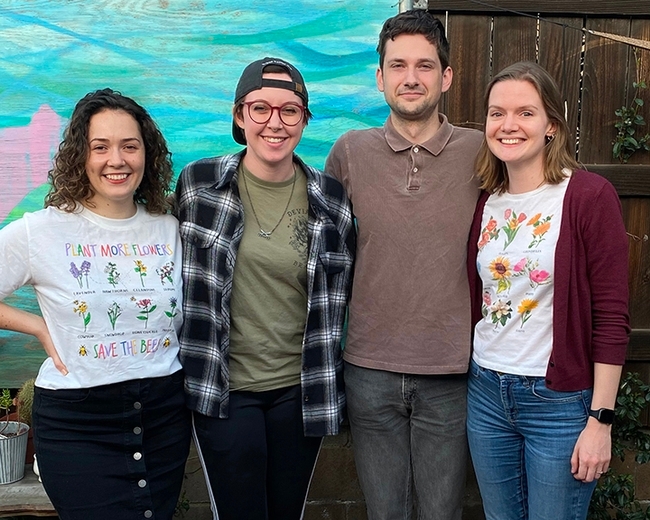
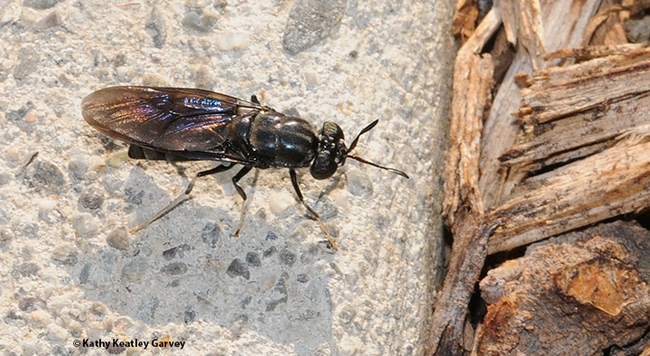
- Author: Kathy Keatley Garvey
No doubt you've seen a praying mantis egg case, or ootheca, on a tree, shrub, fence or post.
But have you ever seen one attached to a clothespin on an outdoor clothes line?
So here we were Thursday afternoon, hanging freshly laundered dog blankets on the clothes line.
We grabbed one clothespin after another, carefully fastening Fido's favorite blankets to the line to dry in the 80-degree temperature.
One more reach....Whoa! What's that?
Can't use that one. There's a ooth on it.
A praying mantis, Stagmomantis limbata, had apparently pinned her hopes to a clothespin. Or maybe that was her PIN number?
"Too funny," commented Lynn Kimsey, director of the Bohart Museum of Entomology and a UC Davis distinguished professor of entomology. "What a weird place to put your ooth."
Our little gravid gal must have climbed the eight-foot-high clothes pole last fall; walked the line (ala Johnny Cash?); and discovered the "perfect place" to deposit her ooth--right above a patch of Mexican sunflowers (Tithonia rotundifola) buzzing with bees and fluttering with butterflies.
"I've seen egg cases on outdoor furniture, predator guards on duck boxes, on buildings between bricks, trees, and even garden implements like pots, watering cans, and tools," said praying mantis expert Andrew Pfeifer, who now studies horticulture/landscape design at North Carolina University. "It's a Stagmomantis limbata ooth for sure; the hatch rate will be 150 or less."
Oothecas don't usually hatch until around June, but with the temperatures soaring here in Vacaville, it could happen "even within the month," Pfeifer says.
In September 2018, we watched a praying mantis deposit her ooth a few feet from that clothesline. That gal chose a redwood stake. (See photos on Bug Squad blog).
Now we wait for the nymphs to emerge...and scramble to eat one another...and prey on bees and butterflies...and the life cycle begins.
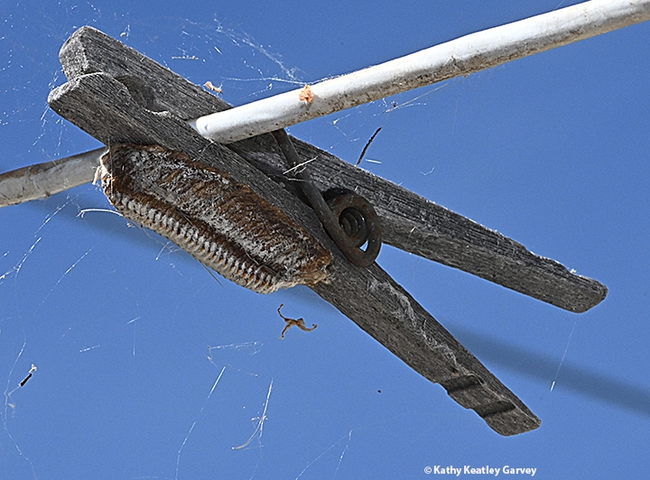
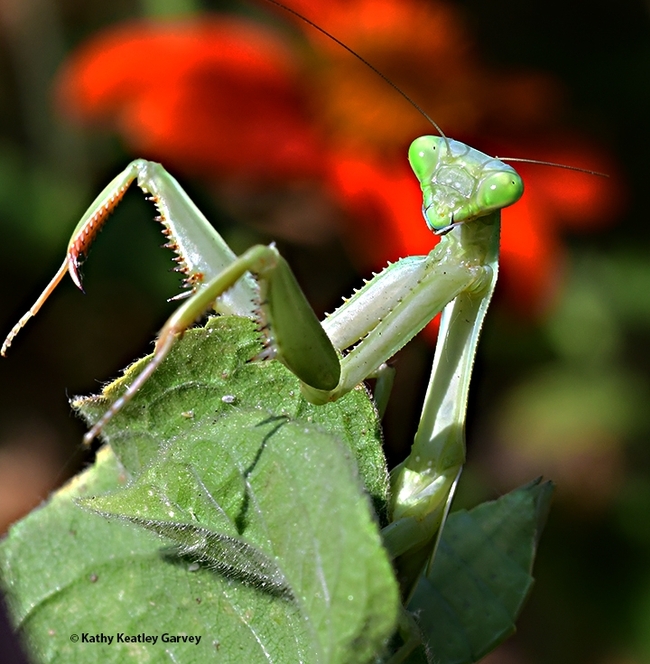
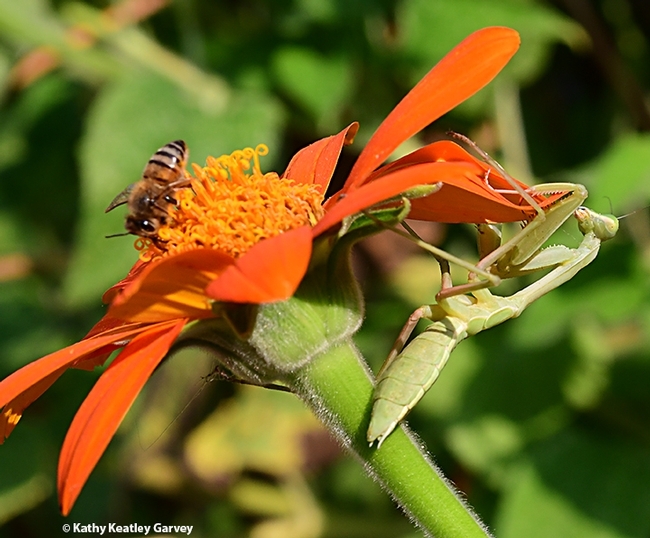
- Author: Kathy Keatley Garvey

Khouri will present his seminar in-person at 4:10 p.m. (Pacific Daylight Time) in 122 Briggs Hall and via Zoom. The Zoom link is https://ucdavis.zoom.us/j/99515291076
"Ziad's work on the mammoth wasps is unique," said host Kimsey, director of the Bohart Museum of Entomology and a distinguished professor of entomology. "This is a family of large bodied distinctive parasitoid wasps that have never had a modern systematic treatment, and the genus and species level taxonomy was a mess. He has brought together modern and classical techniques to bring taxonomic order to this family of wasps and discovered how they evolved."
The Bohart Museum, home of a global collection of eight million insect specimens, houses some 2300 mammoth wasp specimens, mostly from the Americas, Korea and South Africa.
Khouri will deliver his seminar in two parts: "The Evolutionary History of Mammoth Wasps (Hymenoptera: Scoliidae)" and "Comparing the Power of Data-Based Phylogenetic Posterior Predictive Checks in the Context of Cucleotide and Amino Acid Data."
Khouri shares these abstracts from his seminar:
Part 1: "The Evolutionary History of Mammoth Wasps (Hymenoptera: Scoliidae)"
Scoliid wasps comprise a clade of aculeate insects whose larvae are parasitoids of scarabaeid beetle grubs. While scoliids have been studied and used as biological control agents, research into the group's evolution, as well as the stability of scoliid taxonomy, has been limited by a lack of reliable phylogenies. We use ultraconserved element (UCE) data under concatenation and the multispecies coalescent to infer a phylogeny of the Scoliidae. In order to mitigate potential issues arising from model misspecification, we perform data filtering experiments using posterior predictive checks and matched-pairs tests of symmetry. Our analyses confirm the position of Proscolia as sister to all other extant scoliids. We also find strong support for a sister group relationship between the campsomerine genus Colpa and the Scoliini, rendering the Campsomerini non-monophyletic. Campsomerini excluding Colpa (hereafter Campsomerini sensu stricto) is inferred to be monophyletic, with the Australasian genus Trisciloa recovered as sister to the remaining members of the group. Many sampled genera, including Campsomeriella, Dielis, Megascolia, and Scolia are inferred to be non-monophyletic. Analyses incorporating fossil data indicate an Early Cretaceous origin of the crown Scoliidae, with the split between Scoliini + Colpa and Campsomerini s.s. most probably occurring in the Late Cretaceous. Posterior means of Scoliini + Colpa and Campsomerini s.s. crown ages are estimated to be in the Paleogene, though age 95% HPD intervals extend slightly back past the K-Pg boundary, and analyses including fossils of less certain placement result in more posterior mass on older ages. Our estimates of the stem ages of Nearctic scoliid clades are consistent with dispersal across Beringia during the Oligocene or later Eocene. Our study provides a foundation for future research into scoliid wasp evolution and biogeography by being the first to leverage genome-scale data and model-based methods. However, the precision of our dating analyses is constrained by the paucity of well-preserved fossils reliably attributable to the scoliid crown group. Despite concluding that the higher-level taxonomy of the Scoliidae is in dire need of revision, we recommend that taxonomic changes be predicated on datasets that extend the geographic and taxonomic sampling of the current study.
Part II: "Comparing the Power of Data-Based Phylogenetic Posterior Predictive Checks in the Context of Cucleotide and Amino Acid Data"
When used for phylogenetic inference, exonic DNA sequences can be coded in multiple ways, including as nucleotides, amino acids, and codons. In empirical studies, the choice of data type and associated model is often predicated on which model is less expected to be violated in ways that lead to inaccurate inference. Posterior predictive checks are one method for assessing the adequacy of phylogenetic models and potentially providing an indication of inference reliability. We used a simulation-based approach to explore how our ability to detect model inadequacy using phylogenetic posterior prediction, as well as the associated inference errors, may vary with data coding. Specifically, we simulated data under multiple models, including codon models featuring process heterogeneity across lineages, selection heterogeneity across sites, and selection for codon usage. We then performed inference and posterior predictive checks under nucleotide and amino acid models from the GTR family. We found that some simulation conditions resulted in significant differences, between amino acid and nucleotide treatments, in our ability to detect model violation, even when the magnitude of error in an estimate of interest was similar. Moreover, we corroborate the results of other studies indicating that error in tree length estimation is not always correlated with error in topology reconstruction. Although the use of amino acid models generally resulted in more accurate topologies, we found tree length errors to often be greater than for nucleotide models when the data being analyzed were generated using branch-heterogeneous codon models. We show that the magnitude and direction of tree length estimation error can depend on both data coding and properties of the data-generating process. We conclude that if posterior predictive checks are to be used for purposes such as data filtering, practical effect size thresholds indicative of low inference reliability must be established separately for amino acid and nucleotide data. We also advise caution and recommend careful selection of models and data coding when performing analyses where accurate inference of tree length is important.
Khouri joined the UC Davis graduate program in 2012 and is pursuing his doctorate in entomology. His dissertation research involves the phylogenetics, evolution and taxonomy of Scolliidae (Hymenoptera) and phylogenetic posterior prediction. He holds a bachelor's degree in biology (2012) from Notre Dame University - Louaize (NDU).
He did undergraduate research on the identification of bee and other pollinator specimens at the American University of Beirut; assessed genetic diversity in Spartium junceum populations (known as Spanish broom, rush broom, or weaver's broom); and collected specimens for the establishment of an insect collection at NDU. Khouri was a member of the UC Davis team that won the national Linnaean (now Entomology) Games at the 2015 Entomological Society of America meeting. The UC Davis team defeated the University of Florida, winning the competition for its first time in the Games' 32-year history. (See video)
The Bohart Museum, located in Room 1124 of the Academic Surge Building on Crocker Lane, is currently closed to the public. It houses eight million insect specimens, as well as a live "petting zoo" (Madagascar hissing cockroaches, stick insects and tarantuias) and an insect-themed gift shop, now online.
Nematologist Shahid Siddique, assistant professor, UC Davis Department of Entomology and Nematology, coordinates the seminars. For any Zoom technical issues, contact Siddique at ssiddique@ucdavis.edu. (See list of seminars)
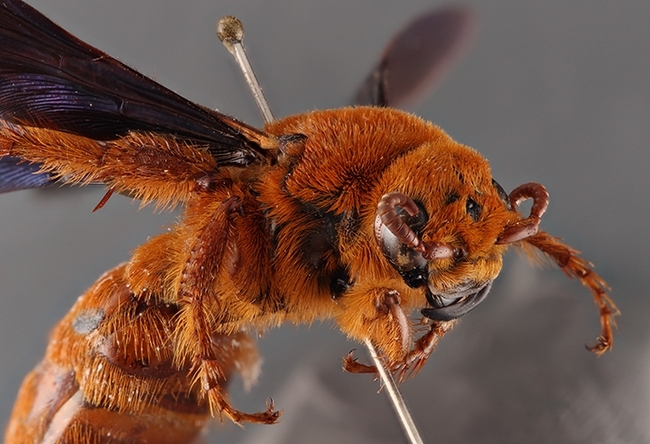
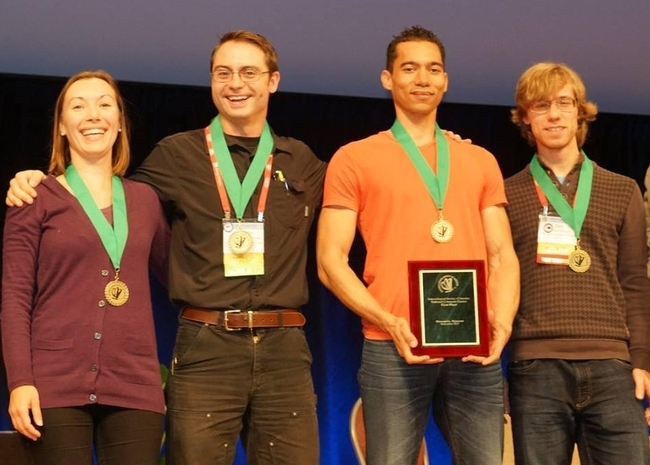
- Author: Kathy Keatley Garvey
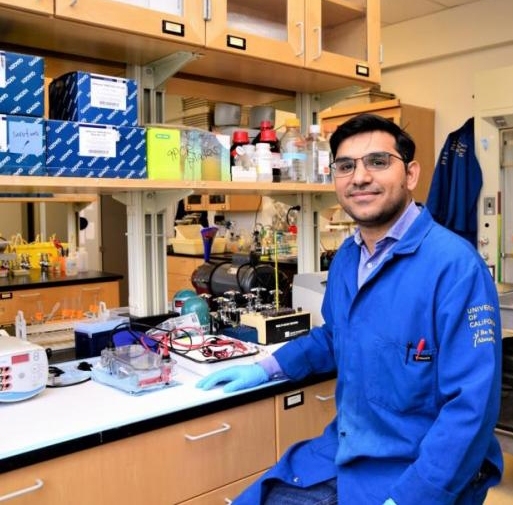
Coordinator Shahid Siddique, assistant professor of nematology, UC Davis Dpartment of Entomology and Nematology, has announced the list of spring quarter seminars.
The seminars will take place at 4:10 p.m., Pacific Time, on Wednesdays, beginning March 30 and will continue through June 1. The in-person seminars will be in 122 Briggs Hall. All also will be broadcast on Zoom. The link:
https://ucdavis.zoom.us/j/99515291076.
Wednesday, March 30 (in-person and virtual)
Ziad Khouri, international graduate student
Bohart Museum of Entomology, UC Davis Department of Entomology and Nematology
Title: "Scoliid Wasp Evolution and Some Adventures with Posterior Predictive Simulation"
Host: Lynn Kimsey, director of the Bohart Museum of Entomology and UC Davis distinguished professor of entomology
Wednesday, April 6 (virtual)
Makedonka Mitreva, professor of medicine and genetics
Washington University School of Medicine, St. Louis
Title: "Multi-omics Applications in Helminth Research"
Host: Shahid Siddique, assistant professor, UC Davis Department of Entomology and Nematology
Wednesday, April 13 (in-person and virtual)
Tobin Hammer, assistant professor, ecology and evolutionary biology
UC Irvine
Title: “Mystery of the Missing Microbes: Why Do Bees Keep Losing Their Symbionts?”
Host: Rachel Vannette, associate professor, UC Davis Department of Entomology and Nematology
Wednesday, April 20 (in-person and virtual)
Jared Ali, assistant professor of entomology
Pennsylvania State University, State College
Title: "Chemical Ecology of Plant Defense and Multi-trophic Interactions: Bad Bugs, Pungent Parasites and Toxic Travelers"
Host: Richard Karban, professor, UC Davis Department of Entomology and Nematology
Wednesday, April 27 (virtual)
Heather Bruce, postdoctoral researcher
Marine Biological Laboratory, University of California, Berkeley
Title: "Evolution and Development of Arthropod Appendages: Novelty and Homology"
Host: Xavier Zahnle, doctoral student, Jason Bond lab, UC Davis Department of Entomology and Nematology
Wednesday, May 4 (virtual)
Scott McArt, assistant professor of entomology
Cornell University, Ithaca, N.Y.
Title: "Pesticide Risk to Pollinators: What We Know and What We Need to Know Better"
Host: Lexie Nichole Martin, doctoral student, Rachel Vannette lab, UC Davis Department of Entomology and Nematology
Wednesday, May 11 (virtual)
Mostafa Zamanian, assistant professor, Department of Pathobiological Sciences
School of Veterinary Medicine, University of Wisconsin, Madison
Title: "Combing Target and Whole-Organism Paradigms for Anthelmintic Discovery"
Host: Shahid Siddique, assistant professor, UC Davis Department of Entomology and Nematology
Wednesday, May 18 (virtual)
Corlett Wood, assistant professor of biology
University of Pennsylvania, Philadelphia
Title: "The Conflict Beneath your Feet: Indirect Effects in Plant-Symbiont Interactions"
Host: Shahid Siddique, assistant professor, UC Davis Department of Entomology and Nematology
Wednesday, May 25 (in-person and virtual)
James R. Carey, UC Davis distinguished professor
UC Davis Department of Entomology and Nematology
Title: "The Conceptual Sweep of a Mathematical Discovery in Insect Demography: From Estimation of Medfly Population Age Structure to an Historical Analysis of U.S. Congress Incumbency Distributions, 1785-2000”
Host: Shahid Siddique, assistant professor, UC Davis Department of Entomology and Nematology
Wednesday, June 1 (in-person and virtual)
Isgouhi Kaloshian, Divisional Dean, Agricultural and Natural Resources
UC Riverside
Title: "Root-Knot Nematode Perception and Immune Signaling in Arabidopsis"
Host: Shahid Siddique, assistant professor, UC Davis Department of Entomology and Nematology
For any technical issues, reach coordinator Shahid Siddique at ssiddique@ucdavis.edu.
